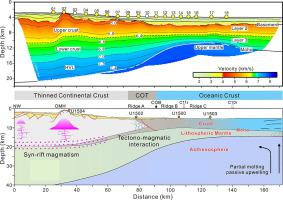Gondwana Research ( IF 7.2 ) Pub Date : 2022-09-07 , DOI: 10.1016/j.gr.2022.09.004 Qiang Wang , Minghui Zhao , Jiazheng Zhang , Haoyu Zhang , Jean-Claude Sibuet , Zizheng Li , Enyuan He , Xuelin Qiu , Wen Peng , Guizhong Chen

|
To improve constraints on breakup processes that eventually lead to seafloor spreading and the subsequent formation of new oceanic crust in the northern margin of the South China Sea (SCS), we collect a 172-km-long deep-penetration wide-angle seismic data OBS2018-L5. In the continental domain, the results present a gradually thinning crust with thickness ranging from ∼17 km to ∼8 km, with a slight thickening crust at the Outer Margin High. The attenuated continental crust is fairly rough and highly offset by distinctly different scale faults system. In the oceanic domain, the top of the basement is highly reflective with weak faulting and relatively constant crust thickness ranging from 5 km to 8 km (average 6 km). The continent-ocean boundary is characterized by an abrupt change in crustal thickness accompanied by a specific boundary between mostly positive gravity anomalies in the oceanic basin and grossly negative anomalies in the thinned continental crust, and between low amplitude, out-of-shape magnetic anomalies in the thinned continental domain and high amplitude, linear anomalies in the oceanic domain. A 0–5 km thick high-velocity layer (7.0–7.5 km/s) is presented in the distal margin, which might represent mafic magma underplating. We also identify other magmatic features such as distinct buried volcanic edifices overprinting the original velocity structure. We propose that three mechanisms control the extension and breakup of the SCS, which are (1) the rapid transition from continental to oceanic crust, (2) elevated potential mantle temperature, and (3) the ductile lower crustal necking. Their interactions lead to the intense thinning of the continental lithosphere, decompression melting of the enriched asthenosphere followed by fast upwelling of mafic melt, relatively strong volcanic activities during the final stage of syn-rift and breakup, and finally generating a margin with intermediately rich magma, referred to as in intermediate-type margin.
中文翻译:

南海北部破裂机制:来自陆海过渡的深部地壳结构的证据
为了改善对最终导致海底扩张和随后在南海北缘(SCS)形成新洋壳的破裂过程的约束,我们收集了一个 172 公里长的深穿透广角地震数据 OBS2018 -L5。在大陆域,结果显示地壳逐渐变薄,厚度从~17 km到~8 km不等,在外缘高地有轻微增厚的地壳。衰减的大陆地壳相当粗糙,并被明显不同的尺度断层系统高度抵消。在大洋域,基底顶部反射性强,断层作用较弱,地壳厚度相对恒定,5~8km(平均6km)。大陆-海洋边界的特征是地壳厚度的突然变化,伴随着洋盆中主要为正的重力异常与变薄的大陆地壳中的严重负异常之间以及在低幅度、变形的磁异常之间的特定边界。在变薄的大陆域和高振幅,海洋域的线性异常。远端边缘出现 0~5 km 厚的高速层(7.0~7.5 km/s),可能代表镁铁质岩浆底蚀。我们还确定了其他岩浆特征,例如覆盖原始速度结构的不同埋藏火山大厦。我们提出三种机制控制南海的伸展和破裂,它们是(1)从大陆地壳到海洋地壳的快速转变,(2)潜在的地幔温度升高,(3) 韧性的下地壳颈缩。它们的相互作用导致大陆岩石圈剧烈变薄,富集软流圈减压熔融,随后镁铁质熔体快速上涌,同裂裂末期火山活动相对强烈,最终形成中富岩浆边缘,称为中间型边距。











































 京公网安备 11010802027423号
京公网安备 11010802027423号